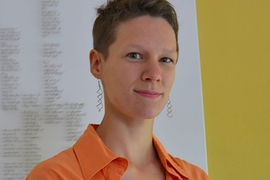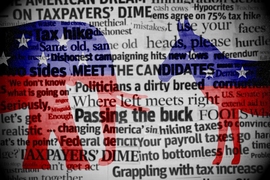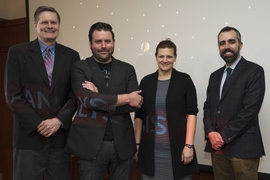As a student in the MIT Laboratory for Information and Decision Systems (LIDS) and in the MIT Institute for Data, Systems, and Society (IDSS), Manon Revel has been investigating how advertising in online publications affects trust in journalism. The topic area is familiar for Revel; growing up, she wanted to be a journalist to follow in her father's footsteps. As a teenager, Revel was assigned her first reporting gig covering a holiday fireworks display for the local radio station near her home on the Atlantic coast of France. Revel researched every one of the dozens of types of fireworks that would be launched and spent hours interviewing the person who would launch them before reporting live on the night. Revel continued reporting for radio and print (she started a high school newspaper that is still active), using the same thorough approach to prepare for each interview.
“I wanted to ask interesting people questions that they had never been asked before, so I read everything I could on them beforehand and then I tried to learn something new,” Revel says.
However, in France, students must narrow in on a field of study by the end of their secondary schooling, and Revel ultimately chose to focus on science — a field in which her penchant for meticulous research and love of discovery would be well served. She completed a bachelor’s and master’s degree in engineering and applied mathematics at École Centrale Paris while pursuing other interests, including journalism, on the side. As she considered what to do next, Revel sought out a more interdisciplinary opportunity, and discovered that at MIT — in particular at LIDS, and in the Master’s Program in Technology and Policy (TPP) at IDSS.
“I always felt like I had these different lives. Coming to MIT was the first time I felt that my interests could finally be put together, and that I could work on everything in unison,” Revel says.
Revel only intended to come for a master’s degree, but she loved the environment and the people so much that she stayed on for a PhD. She joined the new Social and Engineering Systems (SES) doctoral program within IDSS, which combines tools and methods from statistics and information sciences, engineering, and social sciences to tackle significant societal problems. It was the exact sort of interdisciplinary opportunity Revel had been seeking. She works with four academic advisors: professors Ali Jadbabaie in the Department of Civil and Environmental Engineering, Dean Eckles in the MIT Sloan School of Management, Adam Berinsky in the Department Political Science, and IDSS Director Munther Dahleh in the Department of Electrical Engineering and Computer Science. Though operating in the middle of their fields has sometimes been challenging — like having to speak four different languages, Revel says — she’s been thrilled with the opportunities to combine the approaches of disparate disciplines in order to build on all of them and push beyond the boundaries of previous research.
The timing of Revel’s arrival, shortly after the 2016 United States presidential election, was perfect for a deep dive into journalism from an analytical perspective. Current events had underscored the importance of understanding how information is, for better and worse, disseminated in the digital era and made sense of by the people receiving it. Revel’s main project, together with a fellow graduate student in LIDS, Amir Tohidi, has been investigating the effect of “clickbait” ads on reader trust.
As publications have struggled with online revenue models, many have come to increasingly rely on “native ads” that are designed to blend in with news stories and are often supplied by a third-party network. The majority of these ads are clickbait, which Revel and her colleagues define as “something (such as a headline) designed to make readers want to click on a hyperlink, especially when the link leads to content of dubious value or interest.” Revel wanted to quantify exactly how prevalent clickbait is, so she set up a Bayesian text classification program to recognize it. The AI was trained off of two testing sets labelled by users on Amazon’s Mechanical Turk service. Then, Revel scraped over 1.4 million ads from the time period 2016-19, and, using her text classification program, found that more than 80 percent were clickbait. Next, Revel ran two large-scale randomized experiments, which showed that one-time exposure to clickbait near an article could negatively impact readers’ trust in the article and publication. That effect was driven by medium-familiarity publications — defined as outlets recognized by 25-50 percent of the audience. On the contrary, the ads' effect on the most well-known outlets, like CNN and Fox News, was found to be null.
Revel hopes that the project will raise awareness among journalism publications of the risk of losing readership in the long term in order to reap the short-term financial rewards of native advertising. She acknowledges that there’s not an easy solution, as publishers may not be able to afford losing the revenue. However, reader trust in high-quality journalism is a crucial issue in a time of rampant “information disorder,” which is the umbrella term that researchers like Revel use to describe the combination of intentionally or maliciously false information, unwittingly shared misinformation, and true but harmful information that spreads like wildfire through the internet.
Recently, Revel has been working on several other projects that combine approaches across disciplines to quantify and decipher human behavior, with a focus on understanding the ways that people make sense of information and how that impacts their voting decisions. She has been working with sociologists on a project about how audiences’ perception of the news resonates with media coverage. Another project is modeling a voting system where votes may be delegated to better-informed acquaintances.
One could imagine that so much time spent thinking about Revel’s chosen research topics — politics, journalism, untruths — could be draining, but Revel tries not to get drawn into the strong emotions that these subjects can provoke. She sees the goal of her work as understanding, rather than judging, how people think and behave. At the same time, in an occupation focused on information disorder, perhaps it is no surprise that one of the things Revel appreciates most about her colleagues is their authenticity. This, along with their willingness to admit what they don’t know, made it easy to stay on at LIDS and IDSS after her master’s, she says. It’s a wonderful environment in which Revel can do what she has always loved, which is to learn everything she can about a subject — whether fireworks, clickbait, or human behavior — and, now aided by the many scientific approaches she has acquired, try to discover something new.











